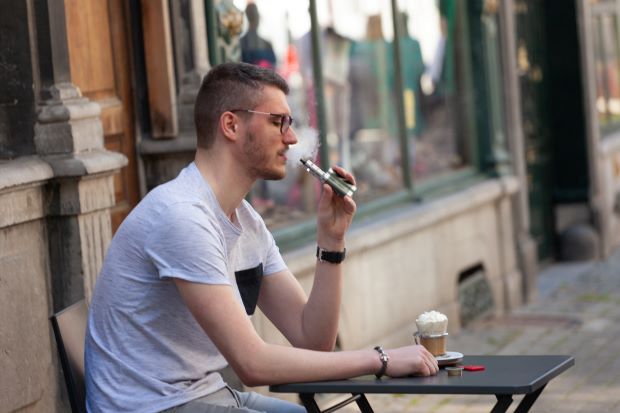- Daily & Weekly newsletters
- Buy & download The Bulletin
- Comment on our articles
‘Typical Belgium’: Health experts criticise the country’s ambitious tobacco plan
Belgium’s new tobacco plan is facing sharp criticism from some health experts, not only because of its ambitious targets and lack of new measures, but also because of the way it lumps together cigarette smokers and users of other nicotine products.
It’s the last point that dismays some public health experts, given evidence that vaping, nicotine pouches and other types of non-combustion tobacco products contain a fraction of the negative health consequences of smoking cigarettes.
Alternative products can also help traditional smokers ultimately quit. The UK has just launched a “swap to stop” scheme that offers smokers vape starter kits as part of its “smoke free” drive.
In Belgium, an estimated 15% of the population were daily smokers in 2018, which is lower than the EU-15 average of 18.4% and represents a 40% decline since 1997.
But the country’s public health targets in the new federal tobacco plan, released in December 2022, are that 0% of youth and 5% of adults are tobacco users by 2040. It also sets out smaller targets to hit before this deadline.
“I was disappointed, but not surprised,” said Frank Baeyens of KU Leuven’s from KUL’s research unit for the psychology of learning and experimental psychopathology. “The goals are extremely ambitious. To achieve them, you’d need divine intervention. And when you look at the plan they’ve put forth, you see only a continuation or ramp up of the same old measures that clearly haven’t worked. It’s typical Belgium.”

Among these measures is a ban on nicotine use in most public places by 2025, including amusement parks and playgrounds. Smoking rooms will also no longer be allowed in the catering sector and tobacco sales will be further restricted.
While the government has said it would “look into” reimbursement for nicotine replacement therapies to help users quit, this action is not yet in the plan.
Smoking prevalence in Belgium has stagnated
“Those classic interventions of taxing, restricting and controlling, have almost reached the end of what they can reach,” Baeyens said, pointing out that while cigarette smoking has decreased overall since its peak, the rate of smokers has stagnated in the last decade.
“There’s nothing new in the plan. I don’t see at all how those measures will reduce the number of smokers,” adds the academic.
Belgium’s new tobacco plan also bans vending machines that sell tobacco products, along with the sale of such products in cafes, festivals and in food shops larger than 400 square metres. Public displays of tobacco products are banned entirely.
These blanket bans apply to all forms of consumable tobacco: “The report literally says any form of nicotine use, whether it be smoking cigars, hookah, nicotine pouches or vaping,” Baeyens said.
“That for me is the biggest mistake. What a health institution should be targeting are those products that have a clear and undoubtedly unhealthy effect, and that’s cigarettes. The other products containing nicotine don’t have combustion, meaning they have only a fraction of the health effects.”
Less harmful alternatives
According to the UK’s Royal College of Physicians, the long-term health risks associated with e-cigarettes “are unlikely to exceed 5% of those associated with smoked tobacco products”.
Public Health England puts the estimate even lower, at “mostly below 1% and far below safety limits for occupational exposure”.

“With this ban you deprive adult smokers of the opportunity to use a much less harmful alternative,” Stefaan Hendrickx of the Flemish Institute for Healthy Living said in an interview with De Morgen.
“The one-sided narrative about safer nicotine products has consequences – the recent smoking survey by the Foundation Against Cancer found that 65% of smokers think an e-cigarette is at least as harmful as a cigarette. Unfortunately, this means people just keep on smoking.”
Another myth Hendrickx and other critics regret is that less-harmful nicotine pouches lead to young people becoming addicted to smoking.
“That is not true,” according to Hendrickx. “There is no scientific study showing that there is a causal link between using nicotine pouches or e-cigarettes and then starting to smoke regularly. It’s unfortunate that such an important debate is conducted in such a one-sided way – we only pay attention to the risks for young people, when we should also pay attention to less harmful alternatives for adults who find it difficult to quit nicotine.”
Scandinavian and Nordic model
Frank Baeyens points to other European countries that have successfully reduced the number of cigarette smokers by leaning into significantly less harmful products, especially in Scandinavian and Nordic countries where nicotine pouches, sometimes called ‘snusing’, have become more popular options.
“Smoking has almost disappeared in the populations of young people in countries like Iceland, Norway and Sweden,” Baeyens said.
“It’s a massive improvement for public health. Countries with a long-term history of this sort of substitution see just a fraction of the cancer rates and cardiovascular diseases others have. It works.”
Fears for youth smokers
Belgium’s plan indeed places an emphasis on lowering the rates of tobacco use for young people, a concern that is naturally replicated in many countries’ tobacco controls.
“There are still too many young people that start smoking,” Belgium’s federal health minister Frank Vandenbroucke told VRT in December when the plan was announced.

“If we really want to have a smoke-free generation in our country then we must ensure that fewer children and young people smoke.”
Vandenbroucke was also vocal about his concern for youngsters smoking when calling for a ban on the sale of nicotine pouches that comes into place on 1 October.
But while some health experts are criticising the plan for being both unrealistic and misguided, others feel it doesn’t go far enough with its measures.
Suzanne Gabriëls of Foundation Against Cancer thought the plan wasn’t ambitious enough with its targets: “The tobacco issue is still very big in our country, but it seems that people still don't have a sense of urgency,” she told Radio 1.
Foundation Against Cancer said they hoped the measures announced so far were only a part of the overall plan.
“At the moment, many things are still missing: for example, more money for monitoring and awareness campaigns,” Gabriëls said. “Also in terms of smoking cessation counselling, there is still a lot of work to do.”
Photos: (main image) ©Belga/Kurt Desplenter; ©Belga/Nicoals Maeterlinck; Goodboro e-cigarette, e-liquids & accessories store, Namur © Damien Maguire/Image Digital; nicotine pouches ©Belga/James Arthur Gekiere


















